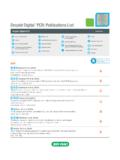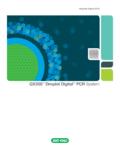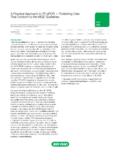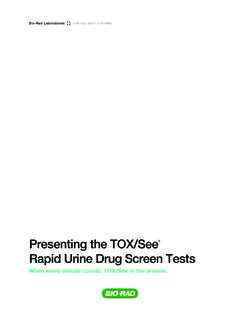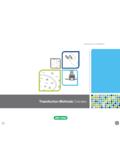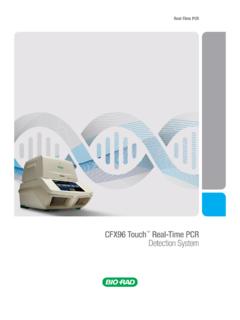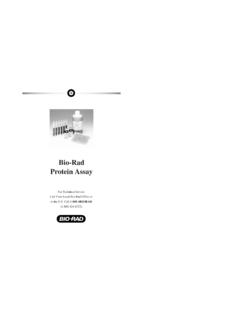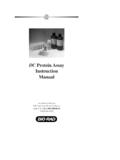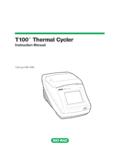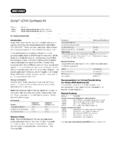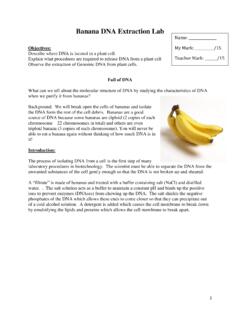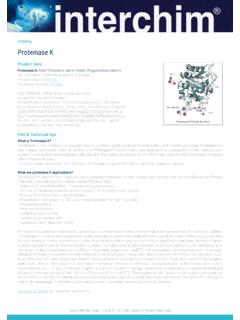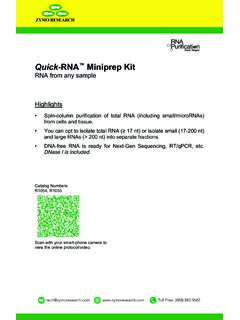Transcription of Real-Time PCR Applications Guide - Bio-Rad Laboratories
1 Applications GuideReal-Time PCR Applications Guide table of contentstable of contents iTable of Contents1. Overview of Real-Time Key Concepts of Real-Time What Is Real-Time PCR? How Real-Time PCR Hallmarks of an Optimized qPCR Assay42. Getting General Experimental Design Considerations for Singleplex or Multiplex? Chemistry DNA-Binding Dyes (SYBR Green I) Fluorescent Primer- and Probe-Based Design and Optimization of SYBR GreenI Primer and Amplicon Assay Validation and Annealing Temperature Assay Performance Evaluation Using Standard Design and Optimization of TaqMan Probe Primer and Probe Assay Validation and Optimization243.
2 Multiplexing Primer and Probe Design for Selection of Reporters and Quenchers for Optimization of Individual Assays Before Validation of Multiplex Optimization of Multiplex Assays30 table of contentstable of contents ii4. Real-Time qPCR Data Absolute When Should Absolute Quantification Be Used? Absolute Quantification Using a Standard Relative When Should Relative Quantification Be Used? Relative Quantification Normalized Against Unit Relative Quantification Normalized to a Reference The 2 CT(Livak) Method The CTMethod Using a Reference The Pfaffl Method435.
3 Gene Expression Experimental RNA Sample RNA Analyzing Nucleic Acid Quantity and cDNA Template Preparation (Reverse Transcription) qPCR Assay Reaction Components for Multiplex Cycling Gene Expression Data Analysis526. Genotyping/Allelic Experimental Design Primer and Probe Design Using TaqMan dna extraction and Sample Reaction Components When Using TaqMan Cycling Protocol Using TaqMan Allelic Discrimination Data Validation of Allelic Discrimination Genotype Assignments727. Genetically Modified Organism (GMO) Experimental dna extraction and Sample Preparation for GMO GM Soy Detection Using a Singleplex SYBR Green I qPCR Reaction Cycling Data GM Soy Detection Using a Multiplex TaqMan qPCR Reaction Cycling Data Analysis828.
4 Product Guide85table of contentstable of contents iiiOverview of Real-Time PCRKey Concepts of Real-Time PCR2 What Is Real-Time PCR?2 How Real-Time PCR Works3 Hallmarks of an Optimized qPCR Assay4 overview of Real-Time PCRkey concepts of Real-Time PCR 2006 Bio-Rad Laboratories , Inc. All rights reserved. Real-Time PCR Applications Guide21. Overview of Real-Time PCRN ucleic acid amplification and detection are among the most valuable techniquesused in biological research today. Scientists in all areas of research basicscience, biotechnology, medicine, forensic science, diagnostics, and more rely on these methods for a wide range of Applications .
5 For some Applications ,qualitative nucleic acid detection is sufficient. Other Applications , however, demanda quantitative analysis. Choosing the best method for your application requires abroad knowledge of available Guide provides an introduction to many of the technical aspects of real-timePCR. It includes guidelines for designing the best Real-Time PCR assay for yourexperiments and explains how Real-Time PCR data are used in various Sections 5 7, we present sample protocols and data that demonstrate the use of Real-Time PCR in specific Applications , namely, gene expression analysis, allelicdiscrimination, and genetically modified organism (GMO) detection.
6 We hope that this Guide will give you the information you need to bring thispowerful technique to your bench and Key Concepts of Real-Time PCR What Is Real-Time PCR?In conventional PCR, the amplified product, or amplicon, is detected by an end-point analysis, by running DNA on an agarose gel after the reaction hasfinished. In contrast, Real-Time PCR allows the accumulation of amplified product tobe detected and measured as the reaction progresses, that is, in real time . Real-Time detection of PCR products is made possible by including in the reactiona fluorescent molecule that reports an increase in the amount of DNA with aproportional increase in fluorescent signal.
7 The fluorescent chemistries employedfor this purpose include DNA-binding dyes and fluorescently labeled sequence-specific primers or probes. Specialized thermal cyclers equipped with fluorescencedetection modules are used to monitor the fluorescence as amplification measured fluorescence reflects the amount of amplified product in each cycle. overview of Real-Time PCRkey concepts of Real-Time PCR 2006 Bio-Rad Laboratories , Inc. All rights reserved. Real-Time PCR Applications Guide3 CycleExponential phaseCTvalueNon-exponentialplateauphase0 10203040 The main advantage of Real-Time PCR over conventional PCR is that Real-Time PCRallows you to determine the starting template copy number with accuracy and high sensitivity over a wide dynamic range.
8 Real-Time PCR results can either bequalitative (presence or absence of a sequence) or quantitative (number of copiesof DNA). Real-Time PCR that is quantitative is also known as qPCR. In contrast,conventional PCR is at best semi-quantitative. Additionally, Real-Time PCR data canbeevaluated without gel electrophoresis, resulting in reduced experiment time andincreased throughput. Finally, because reactions are run and data are evaluated ina closed-tube system, opportunities for contamination are reduced and the needfor postamplification manipulation is How Real-Time PCR WorksTo understand how Real-Time PCR works, let s start by examining a sampleamplification plot (Figure ).
9 In this plot, the PCR cycle number is shown on the x-axis, and the fluorescence from the amplification reaction, which is proportionalto the amount of amplified product in the tube, is shown on the amplification plot shows two phases, an exponential phase followed by a nonexponential plateau phase. During the exponential phase, the amount of PCR product approximately doubles in each cycle. As the reaction proceeds,however, reaction components are consumed, and ultimately one or more of thecomponents becomes limiting. At this point, the reaction slows and enters theplateau phase (cycles 28 40 in Figure ).
10 Fig. Amplification plot. Baseline-subtracted fluorescence is lineoverview of Real-Time PCRkey concepts of Real-Time PCR 2006 Bio-Rad Laboratories , Inc. All rights reserved. Real-Time PCR Applications Guide4 Initially, fluorescence remains at background levels, and increases in fluorescenceare not detectable (cycles 1 18 in Figure ) even though product accumulatesexponentially. Eventually, enough amplified product accumulates to yield adetectable fluorescent signal. The cycle number at which this occurs is called thethreshold cycle, or CT.
